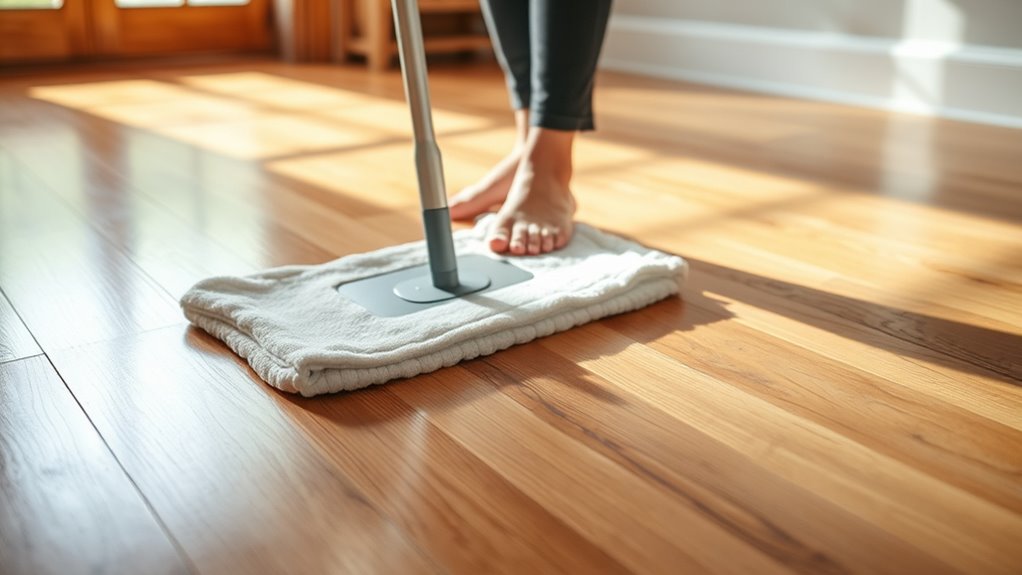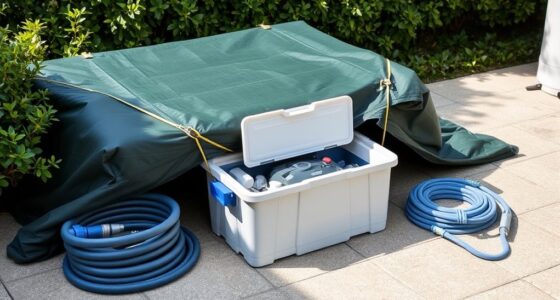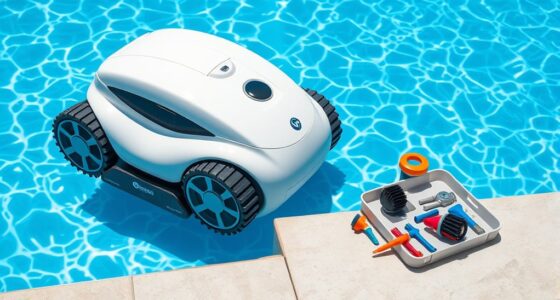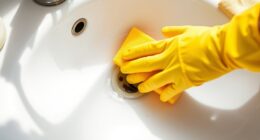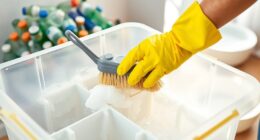To clean hardwood floors without ruining the finish, regularly dust mop with a soft microfiber tool to remove dirt and pet hair, especially in high-traffic areas. Use a slightly damp microfiber cloth or mop with a gentle hardwood-specific cleaner for stubborn spots, avoiding soaking the floor. Always follow the grain of the wood and steer clear of harsh chemicals or abrasive tools. Keep your routine careful—if you want to uncover more effective tips, keep exploring!
Key Takeaways
- Use dry or slightly damp microfiber mops for routine dust mopping and pet hair removal.
- Avoid excessive water; never soak the mop or use overly wet cleaning tools.
- Select gentle, hardwood-specific cleaning solutions for stubborn spots or residues.
- Follow the wood grain during cleaning to prevent scratches and maintain the finish.
- Regularly maintain your cleaning routine to prevent dirt buildup and protect the floor’s surface.

Keeping your hardwood floors clean is essential to maintaining their beauty and longevity. One of the simplest yet most effective ways to do this is by regularly dust mopping. Dust mopping helps remove the daily buildup of dust, dirt, and debris that can scratch the surface over time. Use a soft, dry microfiber mop designed for hardwood floors, as it traps dust without scratching the finish. Make sure to move the mop gently and cover all areas, paying special attention to corners and along baseboards where dust tends to settle. This routine not only keeps your floors looking shiny but also prevents dirt from becoming embedded in the finish. Regular dust mopping also reduces the need for harsh cleaning agents that could potentially damage the finish over time.
Pet hair removal is another critical aspect of cleaning hardwood floors, especially if you have furry friends. Pet hair can quickly accumulate and become ground into the surface, making your floors look dull and unkempt. To effectively remove pet hair, use a microfiber dust mop or a broom with fine bristles. These tools attract pet hair better than regular vacuums or cloths. For stubborn hair, lightly dampen the microfiber mop or use a slightly damp cloth to pick up any remaining strands. Avoid using wet mops or soaking the floor, as excess moisture can damage the wood or cause warping. Regularly cleaning up pet hair not only keeps your floors looking pristine but also reduces allergens and keeps your home healthier. Incorporating proper cleaning techniques can further help preserve the finish and prevent damage.
When dust mopping and pet hair removal, it’s important to do it frequently—at least once a day if you have pets or high foot traffic. This prevents dirt and pet hair from settling deep into the finish, which can make cleaning more difficult later. Always use a dry or slightly damp cloth; never drench the mop or cloth with water, as excess moisture can seep into seams or damage the wood. After dust mopping, you might notice some stubborn spots or sticky residues. In that case, opt for a gentle cleaning solution made specifically for hardwood floors. Lightly dampen your microfiber mop with this cleaner and go over the floor carefully, following the grain of the wood. Avoid abrasive scrubbers or harsh chemicals, as they can strip or dull the finish.
Frequently Asked Questions
Can I Use Steam Mops on Hardwood Floors?
You might wonder if steam cleaning is safe for hardwood floors. While steam mops can be effective for cleaning, they can also damage your hardwood if not used correctly. Excess moisture from steam cleaning can cause warping or finish deterioration. For hardwood maintenance, it’s best to avoid steam mops and opt for damp, well-wrung cloths or specialized wood floor cleaners. This keeps your floors clean without risking damage.
How Often Should I Deep Clean Hardwood Floors?
You should deep clean your hardwood floors about once or twice a year, depending on foot traffic and household needs. Regular cleaning frequency might be weekly, but deep cleaning removes embedded dirt and grime. Use gentle methods that won’t damage the finish, like a damp mop with a hardwood-safe cleaner. This routine keeps your floors looking fresh and preserves their finish without risking damage from over-cleaning.
Are DIY Cleaning Solutions Safe for Finishes?
DIY cleaners can be safe for your hardwood finish if you choose the right ingredients. You should focus on solutions that promote finish safety, like mixing a small amount of mild dish soap with water. Avoid harsh chemicals or acidic substances that can damage the finish. Always test a small, hidden area first, and never soak your floors. Properly prepared DIY cleaners help keep your hardwood looking beautiful without risking damage.
What’s the Best Way to Remove Stubborn Stains?
Imagine you’re gently lifting stubborn stains like tough spots etched onto your hardwood, revealing its natural shine. For effective stain removal, start with a soft cloth dampened in a mixture of warm water and a few drops of gentle dish soap. For more stubborn spots, apply a small amount of baking soda paste, rubbing gently. Always test first to avoid damage, and rinse with clean water to keep your floors gleaming.
How Do I Prevent Future Damage During Cleaning?
To prevent future damage during cleaning, you should take steps to prevent scratches and protect the finish. Use soft, damp cloths or microfiber mops instead of harsh scrubbers. Avoid excessive water, which can warp wood. Place felt pads under furniture legs, and sweep regularly to remove debris. These precautions help maintain your hardwood floors’ beauty and keep the finish intact for years to come.
Conclusion
Now that you know how to clean your hardwood floors with care, treat them like a treasured masterpiece. Gentle cleaning preserves their natural beauty, allowing them to shine like a beacon of warmth in your home. With each careful swipe, you’re nurturing a timeless elegance that reflects your love and effort. Keep your floors gleaming, and they’ll continue to tell your story with grace, inviting you to dance across their polished surface for years to come.

